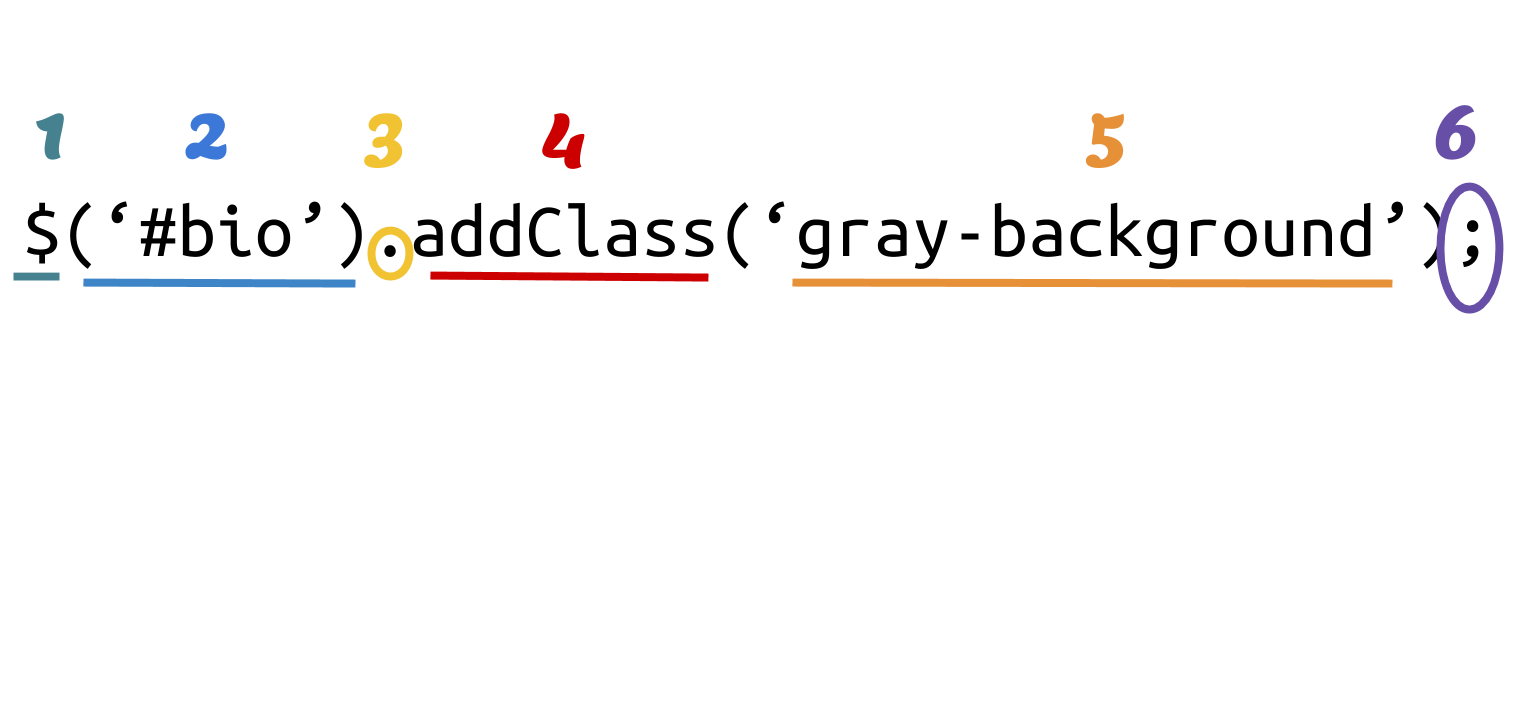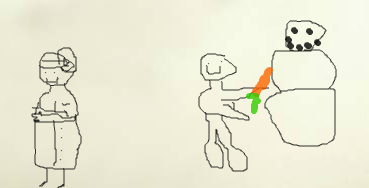JQuery
Simplifying Interactive Web Pages
Learning Objectives
- I can tell someone what jQuery is.
- With the help of docs, I can hide an element using jQuery.
- With the help of docs, I can schedule an “on click” event using jQuery.
What is jQuery?
- A set of alternatives to the built-in JavaScript methods for manipulating the DOM in a web page.
- A library that is extremely popular due to the simplicity it provides.
Review
What is a specific use case for JavaScript?
Change a CSS class when a user clicks something.
var myElement = document.getElementById('#my-special-paragraph');
myElement.addEventListener('click', changeTextColor);
What is a generalized use case for JavaScript?
To provide a set of rules that guide the behavior of a webpage.
- My navigation links should change a color when the user mouses over them.
- If the user tries to submit an empty form, they should be prompted to fill the form correctly.
- Clicking on an
<img>tag should make the image larger.
New: What is a specific use case for jQuery?
Change a CSS class when a user clicks something.
New: What is the generalized use case for jQuery?
To provide a set of rules that guide the behavior of a webpage.
Why JQuery?
JQuery is here to stay
- cross-platform
- lovely syntax
- it’s a marketable skill
- 58% of the top 10,000 websites use jQuery
- source: http://trends.builtwith.com/javascript/jQuery
Something like this in JavaScript...
Get all links in books and add the class important:
var books = document.getElementsByClass("book");
for (var i = 0; i < books.length; i++) {
var links = books[i].getElementsByTagName("a");
for (var j = 0; j < links.length; j++) {
links[j].classList.add("important");
}
}
...Is much simpler in jQuery
This is also JavaScript
$(".book a").addClass("important");
Direct Comparison
// Plain Javascript
var books = document.getElementsByClass("book");
for (var i = 0; i < books.length; i++) {
var links = books[i].getElementsByTagName("a");
for (var j = 0; j < links.length; j++) {
links[j].classList.add("important");
}
}
// JQuery (still JavaScript)
$(".book a").addClass("important");
Basic jQuery Syntax
Getting an element
jQuery element(s) = dollar sign + selector string in parentheses
var allImages = $('img');
var myBio = $('#bio');
Basic Anatomy of a JQuery expression

Basic Anatomy of JQuery, cont.
$('#bio').addClass('gray-background');
- The dollar sign is a shortcut for the function
jQuery(). - Is there a space after the dollar sign?
- No!
- Are there quotes around the selector?
- Yes! It is a selector string.
- As you learn more CSS selectors, you will also be improving your jQuery selector syntax. Woot!
Prevent Confusion Later: Learn the Important Selectors
$('.urgent')- select all elements that have the class “urgent”
$('#bio')- select the single element with the id “bio”
$('div')- select all the divs
$('div.urgent')- select the div with the class urgent
$('footer a.fancy')- select all links with the class fancy that are inside the footer
An Acronym to Remember JQuery Expressions
Doctor Smith Doesn’t Make Pretty Snowmen
- Dollar sign
- Selector
- Dot
- Method
- Parameter
- Semicolon

jQuery Setup
Where does jQuery come from?
<script src="https://code.jquery.com/jquery.js"></script>
- Always include this line before any jQuery code needs to be evaluated
- At Hackbright, please put this inside the
<head>tag
Where does my jQuery code go?
- Save jQuery code that you write with a
.jsfile extension. - Include another script tag for your
.jsfile after the jQuery script tag
An HTML Doc
<!doctype html>
<html>
<head>
</head>
<body>
</body>
</html>
An HTML Doc
<!doctype html>
<html>
<head>
<!-- CSS HERE -->
<!-- JAVASCRIPT HERE -->
</head>
<body>
<!-- HTML HERE -->
</body>
</html>
An HTML Doc
<!doctype html>
<html>
<head>
<link rel="stylesheet" href="stylesheet.css">
<style>
.fancy { color: pink; display: none; }
</style>
<script src="http://code.jquery.com/jquery.js"></script>
</head>
<body>
<div class="fancy">I'm fancy!</div>
<script>
$(".fancy").show();
</script>
</body>
</html>
Methods for Changing the DOM
Changing CSS Classes
$("section").addClass("important"); // no error if already there
$("section").hasClass("important"); // returns true or false
$("section").removeClass("important"); // no error if not there
$("section").toggleClass("important");
Changing HTML Attributes
$("img#cat").attr("src"); // returns src attribute
$("img#cat").attr("src", "cat.jpg"); // add or change
Inserting HTML Elements
<div>
<p>Existing Text.</p>
</div>
- the prepend() method adds to the top of the content of the element;
- the append() method adds to the bottom of the content of the element.
$("p").prepend("Hello ");
$("p").append(" The End!");
Inserting HTML Elements
<div>
<p>Existing Text. The End!</p>
</div>
Changing Contents of Existing HTML Elements
$("section").html(); // returns HTML
$("section").html("Hi"); // sets HTML
Removing HTML Elements
$("section").empty(); // remove children
$("section").remove(); // remove this element + children
Showing/Hiding Elements
$("img").hide();
$("img").show();
$("img").toggle();
Animation Methods
Shrinking and Growing Elements
$("img").slideUp(); // shrink into nothing in position
$("img").slideDown(); // grow into itself in position
$("img").slideToggle(); // toggles via sliding
Other Animations
fadeIn()fadeOut()fadeToggle()
- many many more
Speed of Animation
$("img").slideUp(3000); // milliseconds (3 secs)
- The first param is the amount of time the animation should take to
complete
- If you omit, slideUp and slideDown default to 400ms
A note on chaining methods
Is the following jQuery code allowed?
$("img#cat").attr("src", "cat.jpg").attr("height", 500);
Event Listeners
What is an event listener?
- A list of what will happen when a user interacts with an HTML element (or a group of HTML elements)
- We as programmers need to specify
- the catalyst element
- the type of event being handled
- what will happen.
Two Ways to Schedule an On Click Event
// click event in Plain JavaScript
var myBtn = document.getElementById('special-btn');
myBtn.addEventListener('click', alertMe);
// click event in JavaScript using JQuery
$('#special-btn').on('click', alertMe);
My helper function (no JQuery here):
function alertMe(evt) {
alert("Don't click that, please.");
}
Other event types
Just like in JavaScript!
- mouseover
$('#special-btn').on('mouseover', alertMe); - change
$('input').on('change', alertMe); - submit
$('form').on('submit', alertMe); - keypress
$('input').on('keypress', alertMe);
Practice
Practice 1
<img id="cat" src="cat.jpg" alt="A cute kitten">
.special-border {
border-color: green;
border-radius: 4px;
border-style: solid;
}
$("#cat").on("mouseover", showBorderOnKitten);
Helper function (there is JQuery here):
function showBorderOnKitten(evt) {
$("img#cat").addClass("special-border");
}
Practice 2
$(".trigger-alert").on("change", function (evt) {
alert("Don't do that, please.");
}
);
In Conclusion
How to debug jQuery
- Check the order of your script tags
- Check your syntax
- Read the jQuery docs on the thing you’re trying to do
Coming Up
-exercise time!